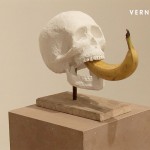This video provides you with a walk-through of Erwin Wurm’s exhibition at the Austrian Pavilion at the Venice Art Biennale 2017.
Erwin Wurm / Austrian Pavilion at Venice Art Biennale 2017. Venice (Italy), May 10, 2017.
> Right-click (Mac: ctrl-click) this link to download Quicktime video file.
Press text:
It is the task of sculpture to produce spatial experiences. Nonetheless, the question arises as to what kind of space this is— because spatial experience has changed. The old spatial experience, and therefore also classical sculpture, were body- centered. The new spatial experience, on the other hand, is centered on machines and media.
Erwin Wurm is one of the few artists who translate changing spatial experience into spatial art itself. The automobile is the main cause for the shift in meanings between mobile and immobile. Hence for Wurm it becomes a favored medium of expression. Unmovable houses, conversely, can suddenly rise up, landing on a hotel or a museum. The states of mobility and immobility become variable. Wurm’s whole oeuvre reflects an apt response in spatial art to the transformation of spatial experience from being body-based to being machine-based. But Wurm has also already entered the territory of media- centered spatial experience with his One Minute Sculptures: instructions to the public that are photographically documented. In front of the pavilion a huge truck stands vertically on its head, i.e. on the driver’s cab, the hood, immobile. Erwin Wurm’s accessible sculpture, a truck that visitors can climb up through the inside and onto its platform, allows them a threefold spatial experience: of body, machine and media. Once they get to the top, the visitors can take a selfie. They experience the socio- political and psyscho-political dimension of every spatial experience. The psychological experience of space can range from the confinement of an elevator car through to the expanse of a prairie, evoking commensurate emotions: the sense of imprisonment, or freedom. Especially today, global migration movements have made the political and psychological dimensions of space more current than ever. Space is now being defined in geopolitical terms again. On the one hand, we once more have borders, fences, and walls. On the other hand, a migrant lives in the unlimited space of information provided by the smartphone. As a result, in Europe we are experiencing the unique spectacle of hundreds of thousands of people arriving on European soil without a passport but with a smartphone, because this smartphone helps them to move and navigate across spaces and countries.
Since messages have been able to travel without bodies, by phone, by Internet, and it is signals and not bodies that invisibly fill spaces, physical space has been perforated, riddled with holes. Restricted space, it turns out, is only restricted for the body. Information space is infinite. And so our living space also becomes different. We take part in events at which we are not physically present. Also living space is perforated. This is why a caravan riddled with holes stand inside the Austrian pavilion. The caravan is per se the paradoxical cross between a dwelling, i.e. immovable property, and a car, i.e. mobility. A caravan that is confined within a space, within a pavilion, has had its purpose removed. A pavilion is not, after all, a garage. The visitors as performers experience both settledness and nomadism, containment and exclusion, mobility and immobility. Since this takes place in a caravan (in German: “Wohnwagen”), this experience clearly also calls on their social and psychological experiences. In the word “Wohnwagen,”, “Wohnung” means dwelling and so has connotations of home and homeland, of family, domicile and domestic country. The “-wagen” part of the word, meaning car, implies “on the road,” traveling to foreign people and distant countries, going abroad. Will the performative public in the Austrian pavilion have a cosmopolitan experience between limitation and dislimitation, between roots and future, between departure and arrival, between resettlement and migration? (Peter Weibel, from: Biennale catalogue Erwin Wurm, 2017)









